Unit 1 Nature in the balance Welcome to the unit&Reading课件(共69张,内嵌视频)2024-2025学年牛津译林版(2020)高中英语必修第三册
文档属性
| 名称 | Unit 1 Nature in the balance Welcome to the unit&Reading课件(共69张,内嵌视频)2024-2025学年牛津译林版(2020)高中英语必修第三册 | 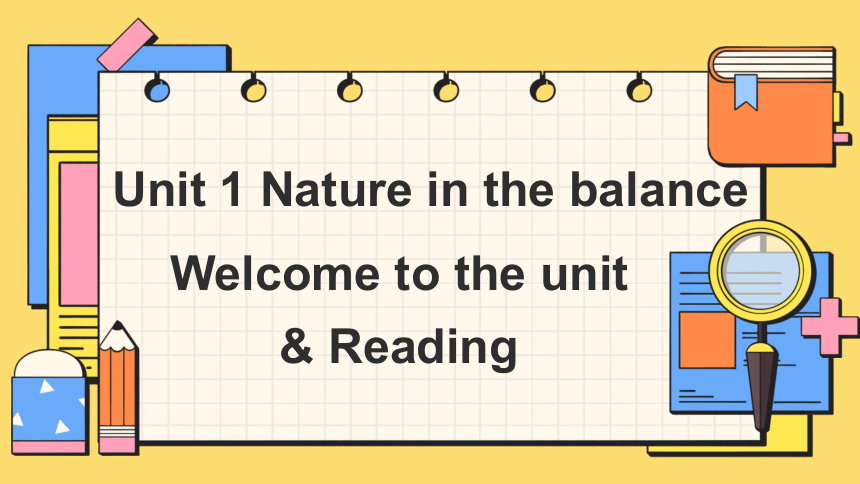 | |
| 格式 | pptx | ||
| 文件大小 | 139.6MB | ||
| 资源类型 | 教案 | ||
| 版本资源 | 牛津译林版(2019) | ||
| 科目 | 英语 | ||
| 更新时间 | 2024-12-19 09:29:09 | ||
图片预览

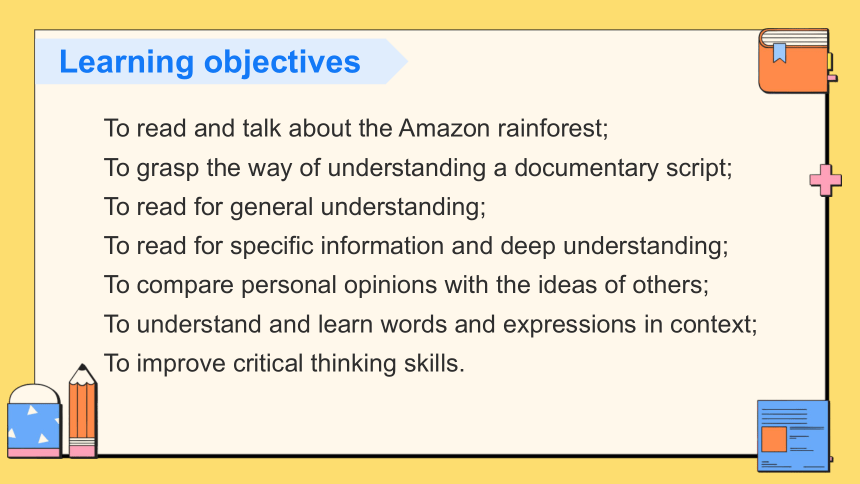
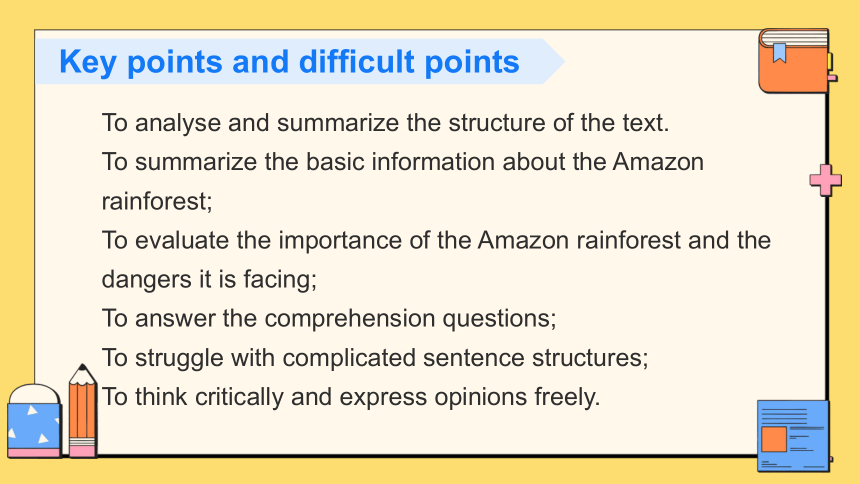

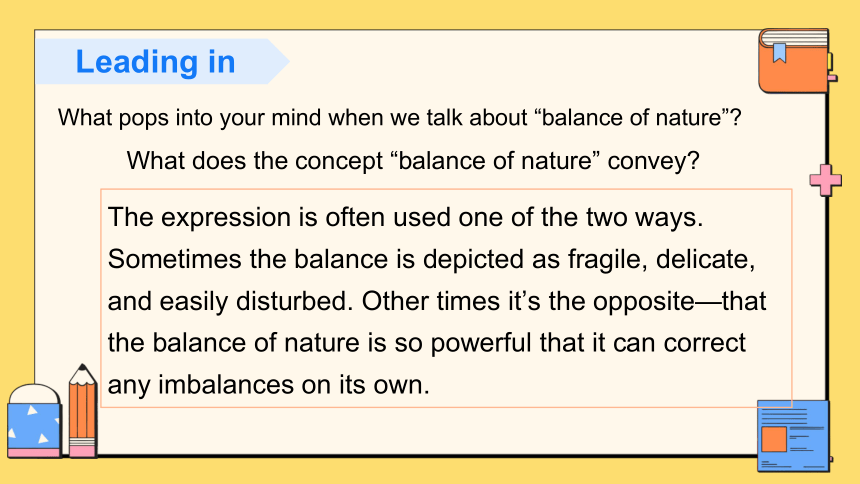
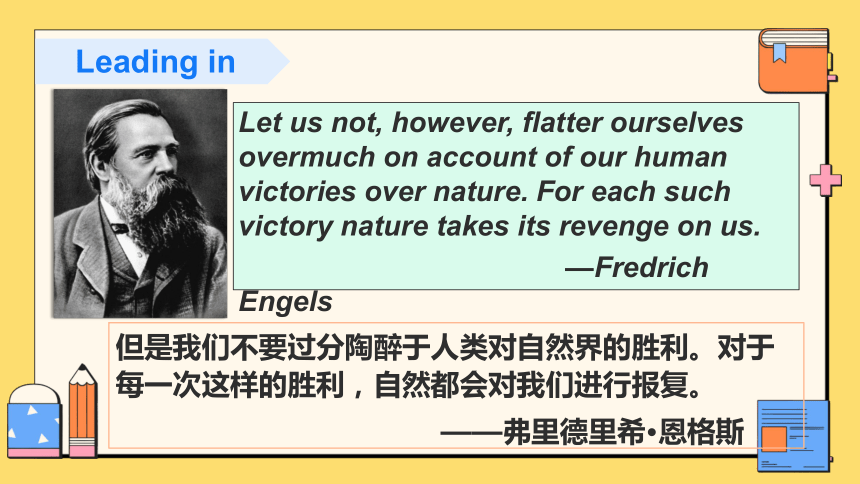

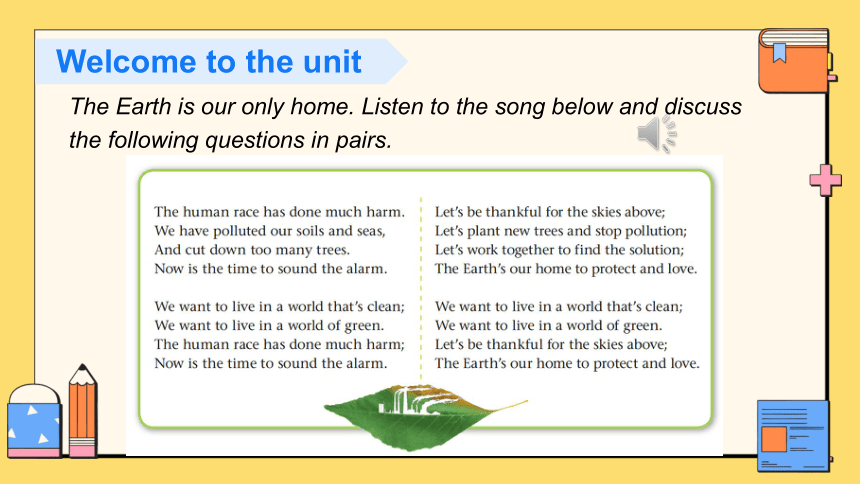
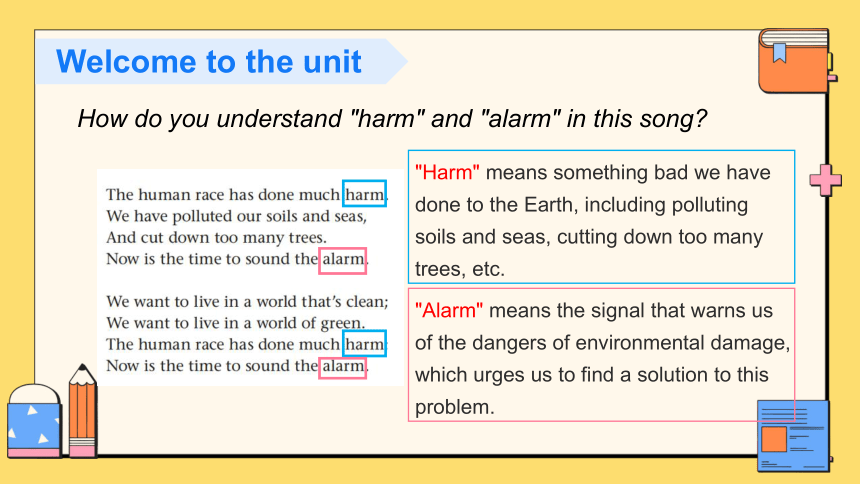
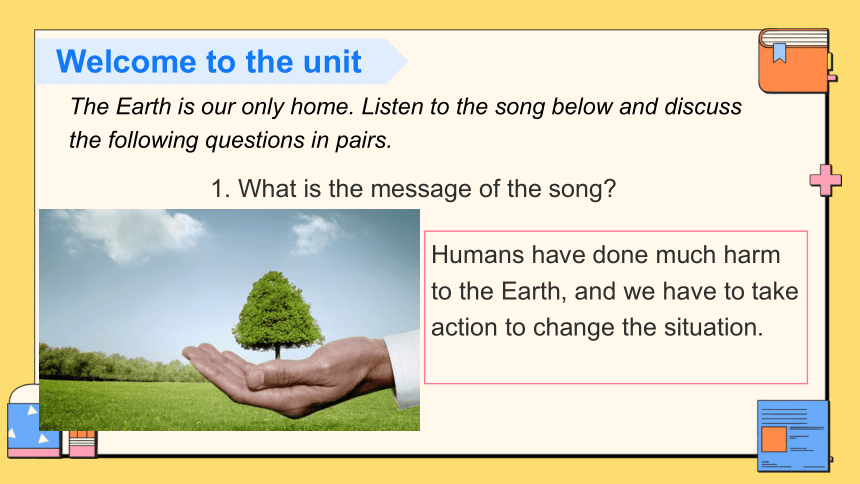
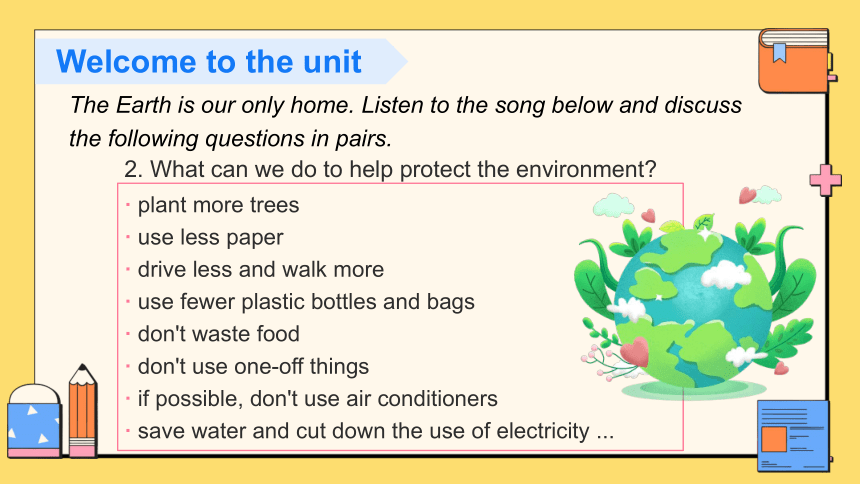
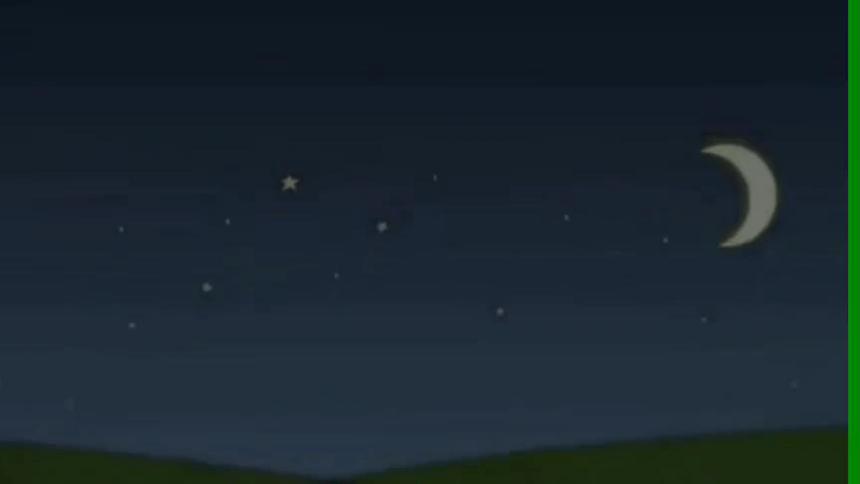
文档简介
(共69张PPT)
Welcome to the unit
& Reading
Unit 1 Nature in the balance
To read and talk about the Amazon rainforest;
To grasp the way of understanding a documentary script;
To read for general understanding;
To read for specific information and deep understanding;
To compare personal opinions with the ideas of others;
To understand and learn words and expressions in context;
To improve critical thinking skills.
Learning objectives
To analyse and summarize the structure of the text.
To summarize the basic information about the Amazon rainforest;
To evaluate the importance of the Amazon rainforest and the dangers it is facing;
To answer the comprehension questions;
To struggle with complicated sentence structures;
To think critically and express opinions freely.
Key points and difficult points
Leading in
Leading in
What does the concept “balance of nature” convey
The expression is often used one of the two ways. Sometimes the balance is depicted as fragile, delicate, and easily disturbed. Other times it’s the opposite—that the balance of nature is so powerful that it can correct any imbalances on its own.
What pops into your mind when we talk about “balance of nature”
但是我们不要过分陶醉于人类对自然界的胜利。对于每一次这样的胜利,自然都会对我们进行报复。
——弗里德里希·恩格斯
Leading in
Let us not, however, flatter ourselves overmuch on account of our human victories over nature. For each such victory nature takes its revenge on us.
—Fredrich Engels
Leading in
Friedrich Engels was a German philosopher, the closest collaborator of Karl Marx in the foundation of scientific communism.
Major works:
The Holy Family
The Condition of the Working Class in England
The Origin of the Family, Private Property and the State
…
The Earth is our only home. Listen to the song below and discuss the following questions in pairs.
Welcome to the unit
How do you understand "harm" and "alarm" in this song
Welcome to the unit
"Harm" means something bad we have done to the Earth, including polluting soils and seas, cutting down too many trees, etc.
"Alarm" means the signal that warns us of the dangers of environmental damage, which urges us to find a solution to this problem.
Welcome to the unit
1. What is the message of the song
Humans have done much harm to the Earth, and we have to take action to change the situation.
The Earth is our only home. Listen to the song below and discuss the following questions in pairs.
Welcome to the unit
2. What can we do to help protect the environment
· plant more trees
· use less paper
· drive less and walk more
· use fewer plastic bottles and bags
· don't waste food
· don't use one-off things
· if possible, don't use air conditioners
· save water and cut down the use of electricity ...
The Earth is our only home. Listen to the song below and discuss the following questions in pairs.
Welcome to the unit
Welcome to the unit
How can humans live in harmony with nature
Reduce the waste
Recycle the waste
Reuse the resources
3R
Reading
Do you know where it is
Reading
Prediction
· What will be talked about in the text according to the title and the picture
· What could be the genre of the article
· What aspects will be mentioned in the following paragraphs
Reading
The Amazon rainforest:
a natural treasure
What could be the genre of the article
documentary script
(of a film, television or radio programme, or photography) using pictures or interviews with people involved in real events to provide a factual record or report.
Reading
Think about two questions
1. What is the purpose of using so many figures
To support the statement and make the statement more persuasive and convincing; to vivify the figures and the facts.
2. Besides just listing the figures, how does the script make the figures, the large figures in particular, understandable
By making comparisons with figures.
The world we live in is full of natural wonders. The documentary script below describes the Amazon rainforest, which is home to a wide range of wildlife. Before you read the script, think about the following questions:
Reading
What plants or animals do you know about What is special about them
What do you think this script is about judging from the title and pictures
What plants or animals do you know about What is special about them
Reading
The cheetah is a large cat native to Africa and central Iran. It is the fastest land animal, estimated to be capable of running at 80 to 128 km/h (50 to 80 mph) with the fastest reliably recorded speeds being 93 and 98 km/h (58 and 61 mph), and as such has several adaptations for speed, including a light build, long thin legs and a long tail.
The cheetah is active mainly during the day and hunting is its major preoccupation, with peaks during dawn and dusk. It feeds on small- to medium-sized prey.
What do you think this script is about judging from the title and picture
Reading
Wildlife and its habitat
Description, features
Benefit for nature and people
Now, read the documentary, check your answers.
Reading
Introduction
Basic information
Plant biodiversity
Different levels
Animal biodiversity
Food chain
Value
Threat
Reading
Para. 1 : Introduction
The status of The Amazon rainforest: _____________________________________.
the largest rainforest in the world
Para. 2 : Basic information
The Amazon rainforest lies on _________________________________.
It named after ______________________________.
The Amazon rainforest and the Amazon River give the __________________________ on the earth.
the South American continent
The Amazon River
richest biodiversity
Reading
_________ : 8 countries and one overseas region
_________: around 6 million square kilometres of forest
_________: about 6,400 km in length
location
Para. 2 : Basic information
size
length
location: The Amazon rainforest crosses into eight countries, including Brazil and Peru, and one overseas region of France, all on the South American continent.
Reading
Para. 2 : Basic information
size: With an area of around 6 million square kilometres, the Amazon rainforest is more than half the size of China.
length: The Amazon River, from which the rainforest gets its name, is close to 6,400 kilometres in length — roughy 100 kilometres longer than the Yangtze River. On its journey from the mountains to the ocean, the river supports many different ecosystems.
Reading
a system of roots
The forest’s different levels support an unbelievable variety of wildlife.
the tops of the tallest trees
the mass of leaf litter
shorter plants with large leaves
towering ancient hardwoods
Para. 3 : Plants
There are _______ levels of plant species.
5
Reading
Para. 3 : Plants
Of the 390,000 plant species known to us, more than 40,000 can be found in the Amazon. This tall and ancient brazil nut tree produces nuts that we can eat; these water lilies are big enough to lie down on. The forest's different levels support an unbelievable variety of wildlife. At the bottom, there is a system of roots beneath the ground. Above that is the mass of leaf litter on the dark forest floor. The next level is made up of shorter plants with large leaves. Then there are the towering ancient hardwoods, and finally the tops of the tallest trees many metres above the ground. Each level of the forest forms its own little world, home to different kinds of living things.
Figure out different layers of the rainforest.
Reading
Para. 4 : Food chain
jaguars
insects
at least 87 species, including frogs
leaves and fruit
microorganisms
feed on
break down
feed on
eat
nutrients
return
Reading
Para. 5 : Significance and danger
1. Why does the Amazon rainforest play a significant role in maintaining the balance of the Earth's ecosystem
the “lungs of the planet”
a treasure house of species for food and medicine materials
2. What's the major danger in the Amazon rainforest
What's the situation of the Amazon rainforest over the past 50 years
major danger: us / human beings
About 17% of the rainforest has disappeared due to human activities.
Reading
Facts about the Amazon forest.
The Amazon is the world's biggest rainforest, larger than the next two largest rainforests—in the Congo Basin and Indonesia—combined.
Nearly two-thirds of the Amazon rainforest is found in Brazil.
70 percent of South America's GDP is produced in areas that receive rainfall or water from the Amazon. The Amazon influences rainfall patterns as far away as the United States.
Reading
Facts about the Amazon forest.
Cattle ranching accounts for roughly 70 percent of deforestation in the Amazon.
Deforestation in the Amazon rainforest has been declining since 2004, mostly due to the falling deforestation rate in Brazil. There are a variety of reasons for the decline, including macroeconomic trends, new protected areas and indigenous territories, improved law enforcement, deforestation monitoring via satellite, pressure from environmental groups, and private sector initiatives.
Reading
Reading
Basic information
· location and size
· Name: getting its name from (1) _________________
· richest (2) _______________
Amazon rainforest
Animals
· more than 1,300 species of birds and over 400 species of (5) ____________
· elements of this forest’s (6) _____________
Plants
· more than 40,000 (3) ________________
· different (4) _________ of the forest
Significance
· fix carbon and producing (7) ________
· having species used for (8) ____________________
Danger
· the major danger: (9) _____________________
· disappearing due to human activities such as (10) ______________ and cattle farming
the Amazon river
biodiversity
plant species
levels
mammals
food chain
oxygen
food or medicine
us/human beings
agriculture
Read the documentary script and write the main idea of each paragraph.
A Understanding the text
A1
Tips: focus on key words, first and last sentences of each paragraph.
Read the documentary script and write the main idea of each paragraph.
A Understanding the text
A1
Para. 1: Introduction to the Amazon rainforest
Para. 2: Basic information about the rainforest
Para. 3: _______________________________________________
Para. 4: _______________________________________________
Para. 5: _______________________________________________
________________________
Plant biodiversity:levels of the rainforest (plants)
Animal biodiversity:food chain (birds and animals)
The rainforest's value to the human race;
threats to the rainforest
Read the documentary script again carefully and fill in the blanks with the figures.
A Understanding the text
A2
8
6 million
6,400
40,000
1,300
400
20%
17%
The Amazon rainforest is home to a wide range of wildlife.
In pairs, discuss the following question.
A Understanding the text
A3
1. What makes the Amazon rainforest a natural treasure according to the script
Tips: think about its beauty, value and uniqueness, give some examples for supporting your ideas.
The Amazon forest breathes life into the planet by fixing carbon and producing over 20 percent of all the Earth’s oxygen. Thus, it is known as the “lungs of the planet”. Moreover, the Amazon forest is a treasure house of species that can be used for food or medicine.
In pairs, discuss the following question.
A Understanding the text
A3
1. What makes the Amazon rainforest a natural treasure according to the script
The Amazon rainforest is unique, beautiful and valuable. It contains 10% of all known species on the Earth. It produces over 20% of the planet's oxygen. Its wonderful plant and animal species have enabled humans to make amazing discoveries.
In pairs, discuss the following question.
A Understanding the text
A3
2. What is your answer to the question at the end of the script Support your opinion with information from the script or other sources.
As the impact of human activities continues to grow and the list of species in danger of extinction becomes longer, we are left with a question: can we afford to damage the “lungs of the planet”
—— The Amazon rainforests: a natural treasure
e.g. Ecological security of the planet—balance of the ecosystem— provide food, oxygen…
In pairs, discuss the following question.
A Understanding the text
A3
2. What is your answer to the question at the end of the script Support your opinion with information from the script or other sources.
Can we afford to damage the “lungs of the plant”
No. The Amazon rainforest is far too important for us to allow it to be destroyed. It helps maintain the balance of the ecosystem and provides our society with food and medicine.
In pairs, discuss the following question.
A Understanding the text
A3
3. Are there any places in China with rich biodiversity like the Amazon rainforest What are they Introduce one to the class.
Name of the place
Basic information
Plant biodiversity
Introduction
Value, threats to rainforest
Animal biodiversity or food chain
1
2
3
4
5
A Understanding the text
What can we do to help maintain a delicate ecological balance
· Reduce, reuse, and recycle. Cut down on what you throw away.
Follow the three "R's" to conserve natural resources and landfill space.
· Shop wisely. Buy less plastic and bring a reusable shopping bag.
· Use long-lasting light bulbs. Energy efficient light bulbs reduce greenhouse gas emissions. Also flip the light switch off when you leave the room!
· Plant a tree. Trees provide food and oxygen. They help save energy, clean the air, and help combat climate change.
· Bike more. Drive less. take public transports.
· …
B Building your language
The passage below is from a website about the Amazon plete the passage with the correct forms of the words and phrases in the box below.
B1
agriculture impact thus due to
variety survive beneath break down
The Amazon rainforest is home to a great (1) ___________ of plant life; however, its soil is surprisingly poor in nutrients. In fact, the soil in the region cannot support (2) ______________ for more than a few years. If a scientist is shown a report listing
variety
agriculture
B Building your language
B1
the nutrients of that soil, he or she will probably think that only desert plants can (3) ___________ in it! Then why is the soil so poor in nutrients For one thing, the rainy season has a(n) (4) ___________ on the soil. In the rainy season, the water level can rise to as high as 12 metres. When the water goes away, it takes away the nutrients in the soil. For another thing,
survive
impact
The passage below is from a website about the Amazon plete the passage with the correct forms of the words and phrases in the box below.
B Building your language
B1
(5) ___________ the Amazon’s hot climate, it is difficult for the soil to build up enough nutrients. Dead plants and animals
(6) ______________________ more quickly. The nutrients are soon taken in by the roots of the plants deep (7) ___________ the ground. As a result, most of the forest’s nutrients are locked up in the plants themselves, (8) ___________ allowing them to grow at an unbelievable speed.
The passage below is from a website about the Amazon plete the passage with the correct forms of the words and phrases in the box below.
due to
are broken down
beneath
thus
B Building your language
B2
The documentary script uses some words with negative prefixes. Note the following prefixes and think of more words formed with them. Then fill in the table below with as many
words as you can.
Prefixes Words
un- unbelievable
dis- disappear
in-/im-/il-/ir- irreplaceable
non- non-smoking
unlimited, unknown, unusual, unreal, unlucky
disagree, disadvantage, dishonest, disabled
incorrect, impolite, illegal, irresponsible
non-stop, non-existent, non-profit, non-fiction
B Building your language
B3
The documentary script compares the size of the Amazon rainforest with that of China, and the length of the Amazon River with that of the Yangtze River.
Why
Making comparisons with familiar places or objects will help readers gain a better understanding, and makes the information more precise and accurate.
B Building your language
B3
Find these comparisons in the script and think of similar comparisons for the figures below.
With an area of around 6 million square kilometres, the Amazon rainforest is more than half the size of China.
The Amazon River, from which the rainforest gets its name, is close to 6,400 kilometres in length—roughly 100 kilometres longer than the Yangtze River.”
B Building your language
B3
Find these comparisons in the script and think of similar comparisons for the figures below.
the same size/length as … more than/larger than/longer than … as large/long as … twice/three times as large/long as …
While the reader may find a large figure too abstract to understand, making comparisons with familiar places or objects will help them gain a better understanding. Here are some expressions used to make comparisons:
Learn this
B Building your language
B3
Find these comparisons in the script and think of similar comparisons for the figures below.
1. It was reported that in 2011, about 34 million people lived in the Amazon. (population of Canada: 37 million; population of Shanghai: 24 million)
about, more than
It was reported that in 2011, about 34 million people lived in the Amazon—that is about Canada’s total population.
…—that is 10 million more than the population of Shanghai.
B Building your language
B3
Find these comparisons in the script and think of similar comparisons for the figures below.
2. From 2001 to 2012, about 177,000 square kilometres of the Amazon rainforest were lost. (size of New Zealand: 268,000 km2; size of Jiangsu: 107,200 km2)
more than half, twice
From 2001 to 2012, about 177,000 square kilometres of the Amazon rainforest were lost—that is more than half the size of New Zealand.
…—that is about twice the size of Jiangsu.
Vocabulary
1. harm
do harm to sb. = do sb. harm 伤害某人;对某人有害
harmful adj. 有害的
be harmful to... 对……有害
harmless adj. 无害的
练习:The gases given off by the factory contain a poisonous substance that is _____________ to people's health.
harmful
Vocabulary
2. variety
a variety of = varieties of 各种各样的;不同种类的
vary vi.(大小、形状等)相异,不同
vary from...to... 由……到……变化
various adj. 各种各样的;不同的
练习:Following a particularly large amount of rainfall earlier, a _____________ of flowers come into blossom.
variety
Vocabulary
3. mass
a mass of/masses of 大量的……
the masses 群众;平民百姓
the mass of 大多数;多数
mass production/unemployment 批量生产/大批失业
massive adj. 巨大的;非常严重的
练习:The _________ of people in that country is Christians.
mass
Vocabulary
4. living
make a living 谋生
earn a/one's living 谋生
everyday living 日常生活
the cost of living 生活开销,生活费
living standards/conditions 生活水平/条件
练习:A drop of water seen through microscope is filled with _____________ things.
living
Vocabulary
5. survive
survive (from) sth. 幸免于……;从……中活过来
A survive B (by…) A 比 B活得长(……)
survive on 靠……生存下来
survival n. 幸存;生还;残存物
survivor n. 幸存者
练习:If he couldn't find his way out of the forest, there would be little chance of _____________.
survival
Vocabulary
6. damage
damage caused by 由……引起的损害
damage to sth. 对……的损害
extensive damage 巨大的伤害(或破坏)
permanent damage 永久性损伤(或破坏)
actual damage 实际损坏; 实际损失
练习:Make sure you insure your camera against loss or _____________.
damage
Vocabulary
7. break down
break through 突破;突围;有重要创见
break up 打碎,破碎;结束;解散;衰落
break in 打断;闯入;训练;使逐渐习惯
break away 脱离;离开;逃脱;摆脱
break off 断绝;中断;断裂;结束;折断
练习:We're trying to ________________ barriers between young people from both communities.
break down
Vocabulary
8. build up
build sth. up 创建;开发
build up one's strength 恢复体力
build sb. up 增强体质
build up one's vocabulary 增加词汇量
练习:He stumped around the country trying to _____________ support.
build up
1. Welcome to the jungle, a huge sea of green alive with the sounds of animals.
a sea of 大片的,大量的
The teacher came in the lecture hall and saw a sea of smiling faces.
老师走进演讲厅,看到了一张张的笑脸。
alive with 充满,到处都是
The yard is alive with flowers in spring.
春天,院子里开满了花。
Language points
2. With an area of around 6 million square kilometres,the Amazon rainforest is more than half the size of China.
倍数表达法
A+be+倍数+the+名词(size/length/width/height)+of+B.
A+be+倍数+比较级+than B.
A+be+倍数+as+形容词原级+as+B.
A+be+倍数+what从句.
The room is three times larger than that room.
这个房间比那个房间大三倍。
Language points
3. The forest's different levels support an unbelievable variety of wildlife.
a variety of 各种各样的
I have bought a variety of books I am crazy about in the bookshop.
我在书店里买了各种各样自己非常爱看的书。
unbelievable adj. 难以相信的,不真实的
It's unbelievable that he succeeded in challenging himself!
令人难以置信的是他成功地挑战了自我!
Language points
4. The next level is made up of shorter plants with large leaves. Then there are the towering ancient hardwoods, and finally the tops of the tallest trees many metres above the ground. Each level of the forest forms its own little world, home to different kinds of living things.
be made up of 由......组成
= be composed of = consist of
Animal bodies are made up of cells.
动物身体是由细胞组成的。
Language points
5. They feed on at least 87 species, including frogs. These frogs, in turn, feed on insects which eat leaves and fruit. When a jaguar dies, a tiny army of microorganisms helps break down its body and return the nutrients to the earth.
feed on 以......为食
in turn 相应地
an tiny army of 一小群
An army of ants matched across the path.
一大群蚂蚁浩浩荡荡地穿过小路。
Language points
6. The Amazon rainforest breathes life into the planet by fixing carbon and producing over 20 per cent of all the Earth's oxygen. Thus, it is often known as the “lungs of the planet".
breathe life into 给......带来起色,注入活力
be known as 被称为......,被认为是......
be known for 因......而闻名
Mrs. brown is known for her hospitality.
布朗夫人以其好客闻名。
Language points
7. As the impact of human activities continues to grow and the list of species in danger of extinction becomes longer, we are left with a question: can we afford to damage the “lungs of the planet”
in danger of extinction 处在灭绝的危险中
afford to do sth. 负担得起做某事
I can not afford to run a car on my salary.
以我的薪水我是养不起汽车的。
Language points
8. The Amazon River, from which the rainforest gets its name, is close to 6,400 kilometres in length—roughly 100 kilometres longer than the Yangtze River.
该句中from which the rainforest gets its name是“介词+which"引导的非限制性定语从句,为先行词the Amazon River提供补充信息,相当于the rainforest gets its name from the Amazon River。先行词和非限制性定语从句之间用逗号隔开。
The house, which was built over a hundred years ago, stood still in the earthquake.
这座一百多年前建成的房子在地震中屹立不倒。
Language points
9. While a significant number of jaguars survive here, they are only one element of this forest’s food chain.
该句中while用于句首,引导让步状语从句,表示“虽然,尽管”。引导让步状语从句的词和短语还有although、though、as、even though、even if。
While I am very willing to play football with you,I do not have much time indeed at present.
尽管我十分愿意和你一起踢足球,但现在我真的没有时间。
Language points
Talk about and learn the Amazon rainforest;
Analyse and summarize the structure of the text;
Grasp the way of understanding a documentary script;
Get general understanding and specific information about the Amazon rainforest;
Learn about and practice words and expressions in context;
Express personal opinions and exchange ideas with others;
Understand and analyze complicated sentence structures.
Summary
Thank you
Welcome to the unit
& Reading
Unit 1 Nature in the balance
To read and talk about the Amazon rainforest;
To grasp the way of understanding a documentary script;
To read for general understanding;
To read for specific information and deep understanding;
To compare personal opinions with the ideas of others;
To understand and learn words and expressions in context;
To improve critical thinking skills.
Learning objectives
To analyse and summarize the structure of the text.
To summarize the basic information about the Amazon rainforest;
To evaluate the importance of the Amazon rainforest and the dangers it is facing;
To answer the comprehension questions;
To struggle with complicated sentence structures;
To think critically and express opinions freely.
Key points and difficult points
Leading in
Leading in
What does the concept “balance of nature” convey
The expression is often used one of the two ways. Sometimes the balance is depicted as fragile, delicate, and easily disturbed. Other times it’s the opposite—that the balance of nature is so powerful that it can correct any imbalances on its own.
What pops into your mind when we talk about “balance of nature”
但是我们不要过分陶醉于人类对自然界的胜利。对于每一次这样的胜利,自然都会对我们进行报复。
——弗里德里希·恩格斯
Leading in
Let us not, however, flatter ourselves overmuch on account of our human victories over nature. For each such victory nature takes its revenge on us.
—Fredrich Engels
Leading in
Friedrich Engels was a German philosopher, the closest collaborator of Karl Marx in the foundation of scientific communism.
Major works:
The Holy Family
The Condition of the Working Class in England
The Origin of the Family, Private Property and the State
…
The Earth is our only home. Listen to the song below and discuss the following questions in pairs.
Welcome to the unit
How do you understand "harm" and "alarm" in this song
Welcome to the unit
"Harm" means something bad we have done to the Earth, including polluting soils and seas, cutting down too many trees, etc.
"Alarm" means the signal that warns us of the dangers of environmental damage, which urges us to find a solution to this problem.
Welcome to the unit
1. What is the message of the song
Humans have done much harm to the Earth, and we have to take action to change the situation.
The Earth is our only home. Listen to the song below and discuss the following questions in pairs.
Welcome to the unit
2. What can we do to help protect the environment
· plant more trees
· use less paper
· drive less and walk more
· use fewer plastic bottles and bags
· don't waste food
· don't use one-off things
· if possible, don't use air conditioners
· save water and cut down the use of electricity ...
The Earth is our only home. Listen to the song below and discuss the following questions in pairs.
Welcome to the unit
Welcome to the unit
How can humans live in harmony with nature
Reduce the waste
Recycle the waste
Reuse the resources
3R
Reading
Do you know where it is
Reading
Prediction
· What will be talked about in the text according to the title and the picture
· What could be the genre of the article
· What aspects will be mentioned in the following paragraphs
Reading
The Amazon rainforest:
a natural treasure
What could be the genre of the article
documentary script
(of a film, television or radio programme, or photography) using pictures or interviews with people involved in real events to provide a factual record or report.
Reading
Think about two questions
1. What is the purpose of using so many figures
To support the statement and make the statement more persuasive and convincing; to vivify the figures and the facts.
2. Besides just listing the figures, how does the script make the figures, the large figures in particular, understandable
By making comparisons with figures.
The world we live in is full of natural wonders. The documentary script below describes the Amazon rainforest, which is home to a wide range of wildlife. Before you read the script, think about the following questions:
Reading
What plants or animals do you know about What is special about them
What do you think this script is about judging from the title and pictures
What plants or animals do you know about What is special about them
Reading
The cheetah is a large cat native to Africa and central Iran. It is the fastest land animal, estimated to be capable of running at 80 to 128 km/h (50 to 80 mph) with the fastest reliably recorded speeds being 93 and 98 km/h (58 and 61 mph), and as such has several adaptations for speed, including a light build, long thin legs and a long tail.
The cheetah is active mainly during the day and hunting is its major preoccupation, with peaks during dawn and dusk. It feeds on small- to medium-sized prey.
What do you think this script is about judging from the title and picture
Reading
Wildlife and its habitat
Description, features
Benefit for nature and people
Now, read the documentary, check your answers.
Reading
Introduction
Basic information
Plant biodiversity
Different levels
Animal biodiversity
Food chain
Value
Threat
Reading
Para. 1 : Introduction
The status of The Amazon rainforest: _____________________________________.
the largest rainforest in the world
Para. 2 : Basic information
The Amazon rainforest lies on _________________________________.
It named after ______________________________.
The Amazon rainforest and the Amazon River give the __________________________ on the earth.
the South American continent
The Amazon River
richest biodiversity
Reading
_________ : 8 countries and one overseas region
_________: around 6 million square kilometres of forest
_________: about 6,400 km in length
location
Para. 2 : Basic information
size
length
location: The Amazon rainforest crosses into eight countries, including Brazil and Peru, and one overseas region of France, all on the South American continent.
Reading
Para. 2 : Basic information
size: With an area of around 6 million square kilometres, the Amazon rainforest is more than half the size of China.
length: The Amazon River, from which the rainforest gets its name, is close to 6,400 kilometres in length — roughy 100 kilometres longer than the Yangtze River. On its journey from the mountains to the ocean, the river supports many different ecosystems.
Reading
a system of roots
The forest’s different levels support an unbelievable variety of wildlife.
the tops of the tallest trees
the mass of leaf litter
shorter plants with large leaves
towering ancient hardwoods
Para. 3 : Plants
There are _______ levels of plant species.
5
Reading
Para. 3 : Plants
Of the 390,000 plant species known to us, more than 40,000 can be found in the Amazon. This tall and ancient brazil nut tree produces nuts that we can eat; these water lilies are big enough to lie down on. The forest's different levels support an unbelievable variety of wildlife. At the bottom, there is a system of roots beneath the ground. Above that is the mass of leaf litter on the dark forest floor. The next level is made up of shorter plants with large leaves. Then there are the towering ancient hardwoods, and finally the tops of the tallest trees many metres above the ground. Each level of the forest forms its own little world, home to different kinds of living things.
Figure out different layers of the rainforest.
Reading
Para. 4 : Food chain
jaguars
insects
at least 87 species, including frogs
leaves and fruit
microorganisms
feed on
break down
feed on
eat
nutrients
return
Reading
Para. 5 : Significance and danger
1. Why does the Amazon rainforest play a significant role in maintaining the balance of the Earth's ecosystem
the “lungs of the planet”
a treasure house of species for food and medicine materials
2. What's the major danger in the Amazon rainforest
What's the situation of the Amazon rainforest over the past 50 years
major danger: us / human beings
About 17% of the rainforest has disappeared due to human activities.
Reading
Facts about the Amazon forest.
The Amazon is the world's biggest rainforest, larger than the next two largest rainforests—in the Congo Basin and Indonesia—combined.
Nearly two-thirds of the Amazon rainforest is found in Brazil.
70 percent of South America's GDP is produced in areas that receive rainfall or water from the Amazon. The Amazon influences rainfall patterns as far away as the United States.
Reading
Facts about the Amazon forest.
Cattle ranching accounts for roughly 70 percent of deforestation in the Amazon.
Deforestation in the Amazon rainforest has been declining since 2004, mostly due to the falling deforestation rate in Brazil. There are a variety of reasons for the decline, including macroeconomic trends, new protected areas and indigenous territories, improved law enforcement, deforestation monitoring via satellite, pressure from environmental groups, and private sector initiatives.
Reading
Reading
Basic information
· location and size
· Name: getting its name from (1) _________________
· richest (2) _______________
Amazon rainforest
Animals
· more than 1,300 species of birds and over 400 species of (5) ____________
· elements of this forest’s (6) _____________
Plants
· more than 40,000 (3) ________________
· different (4) _________ of the forest
Significance
· fix carbon and producing (7) ________
· having species used for (8) ____________________
Danger
· the major danger: (9) _____________________
· disappearing due to human activities such as (10) ______________ and cattle farming
the Amazon river
biodiversity
plant species
levels
mammals
food chain
oxygen
food or medicine
us/human beings
agriculture
Read the documentary script and write the main idea of each paragraph.
A Understanding the text
A1
Tips: focus on key words, first and last sentences of each paragraph.
Read the documentary script and write the main idea of each paragraph.
A Understanding the text
A1
Para. 1: Introduction to the Amazon rainforest
Para. 2: Basic information about the rainforest
Para. 3: _______________________________________________
Para. 4: _______________________________________________
Para. 5: _______________________________________________
________________________
Plant biodiversity:levels of the rainforest (plants)
Animal biodiversity:food chain (birds and animals)
The rainforest's value to the human race;
threats to the rainforest
Read the documentary script again carefully and fill in the blanks with the figures.
A Understanding the text
A2
8
6 million
6,400
40,000
1,300
400
20%
17%
The Amazon rainforest is home to a wide range of wildlife.
In pairs, discuss the following question.
A Understanding the text
A3
1. What makes the Amazon rainforest a natural treasure according to the script
Tips: think about its beauty, value and uniqueness, give some examples for supporting your ideas.
The Amazon forest breathes life into the planet by fixing carbon and producing over 20 percent of all the Earth’s oxygen. Thus, it is known as the “lungs of the planet”. Moreover, the Amazon forest is a treasure house of species that can be used for food or medicine.
In pairs, discuss the following question.
A Understanding the text
A3
1. What makes the Amazon rainforest a natural treasure according to the script
The Amazon rainforest is unique, beautiful and valuable. It contains 10% of all known species on the Earth. It produces over 20% of the planet's oxygen. Its wonderful plant and animal species have enabled humans to make amazing discoveries.
In pairs, discuss the following question.
A Understanding the text
A3
2. What is your answer to the question at the end of the script Support your opinion with information from the script or other sources.
As the impact of human activities continues to grow and the list of species in danger of extinction becomes longer, we are left with a question: can we afford to damage the “lungs of the planet”
—— The Amazon rainforests: a natural treasure
e.g. Ecological security of the planet—balance of the ecosystem— provide food, oxygen…
In pairs, discuss the following question.
A Understanding the text
A3
2. What is your answer to the question at the end of the script Support your opinion with information from the script or other sources.
Can we afford to damage the “lungs of the plant”
No. The Amazon rainforest is far too important for us to allow it to be destroyed. It helps maintain the balance of the ecosystem and provides our society with food and medicine.
In pairs, discuss the following question.
A Understanding the text
A3
3. Are there any places in China with rich biodiversity like the Amazon rainforest What are they Introduce one to the class.
Name of the place
Basic information
Plant biodiversity
Introduction
Value, threats to rainforest
Animal biodiversity or food chain
1
2
3
4
5
A Understanding the text
What can we do to help maintain a delicate ecological balance
· Reduce, reuse, and recycle. Cut down on what you throw away.
Follow the three "R's" to conserve natural resources and landfill space.
· Shop wisely. Buy less plastic and bring a reusable shopping bag.
· Use long-lasting light bulbs. Energy efficient light bulbs reduce greenhouse gas emissions. Also flip the light switch off when you leave the room!
· Plant a tree. Trees provide food and oxygen. They help save energy, clean the air, and help combat climate change.
· Bike more. Drive less. take public transports.
· …
B Building your language
The passage below is from a website about the Amazon plete the passage with the correct forms of the words and phrases in the box below.
B1
agriculture impact thus due to
variety survive beneath break down
The Amazon rainforest is home to a great (1) ___________ of plant life; however, its soil is surprisingly poor in nutrients. In fact, the soil in the region cannot support (2) ______________ for more than a few years. If a scientist is shown a report listing
variety
agriculture
B Building your language
B1
the nutrients of that soil, he or she will probably think that only desert plants can (3) ___________ in it! Then why is the soil so poor in nutrients For one thing, the rainy season has a(n) (4) ___________ on the soil. In the rainy season, the water level can rise to as high as 12 metres. When the water goes away, it takes away the nutrients in the soil. For another thing,
survive
impact
The passage below is from a website about the Amazon plete the passage with the correct forms of the words and phrases in the box below.
B Building your language
B1
(5) ___________ the Amazon’s hot climate, it is difficult for the soil to build up enough nutrients. Dead plants and animals
(6) ______________________ more quickly. The nutrients are soon taken in by the roots of the plants deep (7) ___________ the ground. As a result, most of the forest’s nutrients are locked up in the plants themselves, (8) ___________ allowing them to grow at an unbelievable speed.
The passage below is from a website about the Amazon plete the passage with the correct forms of the words and phrases in the box below.
due to
are broken down
beneath
thus
B Building your language
B2
The documentary script uses some words with negative prefixes. Note the following prefixes and think of more words formed with them. Then fill in the table below with as many
words as you can.
Prefixes Words
un- unbelievable
dis- disappear
in-/im-/il-/ir- irreplaceable
non- non-smoking
unlimited, unknown, unusual, unreal, unlucky
disagree, disadvantage, dishonest, disabled
incorrect, impolite, illegal, irresponsible
non-stop, non-existent, non-profit, non-fiction
B Building your language
B3
The documentary script compares the size of the Amazon rainforest with that of China, and the length of the Amazon River with that of the Yangtze River.
Why
Making comparisons with familiar places or objects will help readers gain a better understanding, and makes the information more precise and accurate.
B Building your language
B3
Find these comparisons in the script and think of similar comparisons for the figures below.
With an area of around 6 million square kilometres, the Amazon rainforest is more than half the size of China.
The Amazon River, from which the rainforest gets its name, is close to 6,400 kilometres in length—roughly 100 kilometres longer than the Yangtze River.”
B Building your language
B3
Find these comparisons in the script and think of similar comparisons for the figures below.
the same size/length as … more than/larger than/longer than … as large/long as … twice/three times as large/long as …
While the reader may find a large figure too abstract to understand, making comparisons with familiar places or objects will help them gain a better understanding. Here are some expressions used to make comparisons:
Learn this
B Building your language
B3
Find these comparisons in the script and think of similar comparisons for the figures below.
1. It was reported that in 2011, about 34 million people lived in the Amazon. (population of Canada: 37 million; population of Shanghai: 24 million)
about, more than
It was reported that in 2011, about 34 million people lived in the Amazon—that is about Canada’s total population.
…—that is 10 million more than the population of Shanghai.
B Building your language
B3
Find these comparisons in the script and think of similar comparisons for the figures below.
2. From 2001 to 2012, about 177,000 square kilometres of the Amazon rainforest were lost. (size of New Zealand: 268,000 km2; size of Jiangsu: 107,200 km2)
more than half, twice
From 2001 to 2012, about 177,000 square kilometres of the Amazon rainforest were lost—that is more than half the size of New Zealand.
…—that is about twice the size of Jiangsu.
Vocabulary
1. harm
do harm to sb. = do sb. harm 伤害某人;对某人有害
harmful adj. 有害的
be harmful to... 对……有害
harmless adj. 无害的
练习:The gases given off by the factory contain a poisonous substance that is _____________ to people's health.
harmful
Vocabulary
2. variety
a variety of = varieties of 各种各样的;不同种类的
vary vi.(大小、形状等)相异,不同
vary from...to... 由……到……变化
various adj. 各种各样的;不同的
练习:Following a particularly large amount of rainfall earlier, a _____________ of flowers come into blossom.
variety
Vocabulary
3. mass
a mass of/masses of 大量的……
the masses 群众;平民百姓
the mass of 大多数;多数
mass production/unemployment 批量生产/大批失业
massive adj. 巨大的;非常严重的
练习:The _________ of people in that country is Christians.
mass
Vocabulary
4. living
make a living 谋生
earn a/one's living 谋生
everyday living 日常生活
the cost of living 生活开销,生活费
living standards/conditions 生活水平/条件
练习:A drop of water seen through microscope is filled with _____________ things.
living
Vocabulary
5. survive
survive (from) sth. 幸免于……;从……中活过来
A survive B (by…) A 比 B活得长(……)
survive on 靠……生存下来
survival n. 幸存;生还;残存物
survivor n. 幸存者
练习:If he couldn't find his way out of the forest, there would be little chance of _____________.
survival
Vocabulary
6. damage
damage caused by 由……引起的损害
damage to sth. 对……的损害
extensive damage 巨大的伤害(或破坏)
permanent damage 永久性损伤(或破坏)
actual damage 实际损坏; 实际损失
练习:Make sure you insure your camera against loss or _____________.
damage
Vocabulary
7. break down
break through 突破;突围;有重要创见
break up 打碎,破碎;结束;解散;衰落
break in 打断;闯入;训练;使逐渐习惯
break away 脱离;离开;逃脱;摆脱
break off 断绝;中断;断裂;结束;折断
练习:We're trying to ________________ barriers between young people from both communities.
break down
Vocabulary
8. build up
build sth. up 创建;开发
build up one's strength 恢复体力
build sb. up 增强体质
build up one's vocabulary 增加词汇量
练习:He stumped around the country trying to _____________ support.
build up
1. Welcome to the jungle, a huge sea of green alive with the sounds of animals.
a sea of 大片的,大量的
The teacher came in the lecture hall and saw a sea of smiling faces.
老师走进演讲厅,看到了一张张的笑脸。
alive with 充满,到处都是
The yard is alive with flowers in spring.
春天,院子里开满了花。
Language points
2. With an area of around 6 million square kilometres,the Amazon rainforest is more than half the size of China.
倍数表达法
A+be+倍数+the+名词(size/length/width/height)+of+B.
A+be+倍数+比较级+than B.
A+be+倍数+as+形容词原级+as+B.
A+be+倍数+what从句.
The room is three times larger than that room.
这个房间比那个房间大三倍。
Language points
3. The forest's different levels support an unbelievable variety of wildlife.
a variety of 各种各样的
I have bought a variety of books I am crazy about in the bookshop.
我在书店里买了各种各样自己非常爱看的书。
unbelievable adj. 难以相信的,不真实的
It's unbelievable that he succeeded in challenging himself!
令人难以置信的是他成功地挑战了自我!
Language points
4. The next level is made up of shorter plants with large leaves. Then there are the towering ancient hardwoods, and finally the tops of the tallest trees many metres above the ground. Each level of the forest forms its own little world, home to different kinds of living things.
be made up of 由......组成
= be composed of = consist of
Animal bodies are made up of cells.
动物身体是由细胞组成的。
Language points
5. They feed on at least 87 species, including frogs. These frogs, in turn, feed on insects which eat leaves and fruit. When a jaguar dies, a tiny army of microorganisms helps break down its body and return the nutrients to the earth.
feed on 以......为食
in turn 相应地
an tiny army of 一小群
An army of ants matched across the path.
一大群蚂蚁浩浩荡荡地穿过小路。
Language points
6. The Amazon rainforest breathes life into the planet by fixing carbon and producing over 20 per cent of all the Earth's oxygen. Thus, it is often known as the “lungs of the planet".
breathe life into 给......带来起色,注入活力
be known as 被称为......,被认为是......
be known for 因......而闻名
Mrs. brown is known for her hospitality.
布朗夫人以其好客闻名。
Language points
7. As the impact of human activities continues to grow and the list of species in danger of extinction becomes longer, we are left with a question: can we afford to damage the “lungs of the planet”
in danger of extinction 处在灭绝的危险中
afford to do sth. 负担得起做某事
I can not afford to run a car on my salary.
以我的薪水我是养不起汽车的。
Language points
8. The Amazon River, from which the rainforest gets its name, is close to 6,400 kilometres in length—roughly 100 kilometres longer than the Yangtze River.
该句中from which the rainforest gets its name是“介词+which"引导的非限制性定语从句,为先行词the Amazon River提供补充信息,相当于the rainforest gets its name from the Amazon River。先行词和非限制性定语从句之间用逗号隔开。
The house, which was built over a hundred years ago, stood still in the earthquake.
这座一百多年前建成的房子在地震中屹立不倒。
Language points
9. While a significant number of jaguars survive here, they are only one element of this forest’s food chain.
该句中while用于句首,引导让步状语从句,表示“虽然,尽管”。引导让步状语从句的词和短语还有although、though、as、even though、even if。
While I am very willing to play football with you,I do not have much time indeed at present.
尽管我十分愿意和你一起踢足球,但现在我真的没有时间。
Language points
Talk about and learn the Amazon rainforest;
Analyse and summarize the structure of the text;
Grasp the way of understanding a documentary script;
Get general understanding and specific information about the Amazon rainforest;
Learn about and practice words and expressions in context;
Express personal opinions and exchange ideas with others;
Understand and analyze complicated sentence structures.
Summary
Thank you
同课章节目录
- Unit 1 Nature in the balance
- Welcome to the unit
- Reading
- Grammar and usage
- Integrated skills
- Extended reading
- Project
- Unit 2 Natural disasters
- Welcome to the unit
- Reading
- Grammar and usage
- Integrated skills
- Extended reading
- Project
- Unit 3 The world online
- Welcome to the unit
- Reading
- Grammar and usage
- Integrated skills
- Extended reading
- Project
- Unit 4 Scientists who changed the world
- Welcome to the unit
- Reading
- Grammar and usage
- Integrated skills
- Extended reading
- Project
